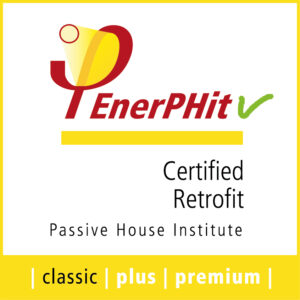Author: Naman Sukhija, PHI
Technically, anybody can build a Passive House building, because the standard itself is not trademarked. The Passive House standard and it’s principles are open for any and all to use, which is why both certified and non-certified buildings can be found on the Passive House project database. However, there are some major benefits of going through the official certification process.
Building certification is a quality assurance technique to ensure that the building functions as it was planned. The building details are carefully and comprehensively examined and the Passive House certification is awarded only if the building meets the respective building certification criteria without exception.
Typically, new buildings are certified as a “Certified Passive House”. For refurbished buildings, the Passive House standard cannot always be achieved, therefore the Passive House Institute (PHI) has developed the “EnerPHit” standard. Buildings which are very close to the Passive House criteria but cannot comply completely due to various reasons (e.g. small buildings in cold and shaded locations) can apply for “Low Energy Building” certification.

The third-party quality assurance provided by building certification has benefits for all stakeholders involved, directly or indirectly.
For the building developer/ owner/ occupants:
The certification ensures that the building will actually perform as per the energy standard it was designed for and the occupants are guaranteed high thermal comfort. This means, the occupants can rest assured that they won’t be startled by their energy bills and will enjoy the good air quality and even surface temperatures. There are many articles available worldwide showing the impact of thermal comfort on the productivity and mood of the occupants.
The reviews made by the accredited building certifier during the process also helps in reducing the construction costs in a lot of cases by avoiding many possible slip-ups. The good indoor comfort and low operational costs of the building mean lower building vacancy rate. As the building has gone through an independent quality assessment and can prove its energy efficiency, the property value tends to increase in the market and also leads to higher rental rates.
PHI building certification also makes the project eligible for many subsidies around the world. Passive House Institute has also partnered with institutions worldwide to create synergies between PHI certifications and other green building standards to simplify the certification process.
The certificate is also used by many building owners to market their building, as well as their company, as the project stands out from many similar buildings which require much more energy to operate.
Also, it always feels great that everyone involved contributed to reducing the greenhouse emissions which a conventional building would have emitted during its lifecycle otherwise.

For the designer/ consultant:
A thorough review of the building documents by the certifier gives an additional sense of security and help in preventing errors during the building design, construction or operation. The certificate also acts as a seal of assurance that the client’s expectations are met in terms of building energy-efficiency.
The designer/ consultant polish their portfolio and can market their skills in developing highly energy-efficient buildings. Furthermore, designing a Passive House also helps to earn or renew the Passive House Designer/ Consultant certificate.
For the tradespeople:
Tradespeople involved in the certified Passive House project can submit the project documentation to renew their Passive House Tradesperson certificate and can demonstrate their experience in the construction of energy-efficient buildings and know-how of the involved components. A tradesperson with experience of constructing a certified Passive House tends to understand its uniqueness and requirements in better and therefore contributes significantly to the project`s success.

The building certification guide can be used to answer many questions regarding the procedure and technical specifications for the documentation like
- What is the overall procedure of building certification?
- When to contact the certifier and where to find them?
- Which documents will be required for certification?
It also contains very detailed technical specifications and is a helpful tool for everyone involved in the Passive House project.
Have questions regarding building certification not answered by the guide? Feel free to contact us at building.certification@passiv.de!








 Carl supports our international communication activities and is the point of contact for administrative enquiries.
Carl supports our international communication activities and is the point of contact for administrative enquiries.